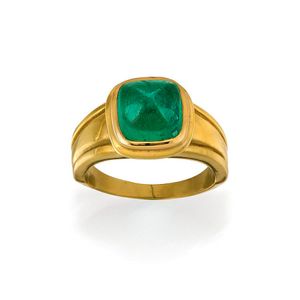Emerald Ring by Barry Kieselstein-Cord
You must be a subscriber, and be logged in to view price and dealer details.
Subscribe Now to view actual auction price for this item
When you subscribe, you have the option of setting the currency in which to display prices to $Au, $US, $NZ or Stg.
- Emeralds - Emeralds have been used in jewellery making for thousands of years, and are prized for their deep green colour, which is caused by the presence of chromium and vanadium in the mineral beryl. Because of their rare colour, emeralds are often more valuable than diamonds of a similar size and quality. In jewellery making, emeralds are typically cut into round or oval shapes to maximize their color and clarity. They are often set in gold or platinum and used as the centrepiece of a piece of jewellery, such as a ring or necklace. They can also be used in combination with other gems, such as diamonds, to create intricate and beautiful designs.
- Collet Setting - A collet setting in jewellery is a type of setting that is used to hold a gemstone or other decorative element securely in place. The collet is a ring of metal that surrounds the stone and holds it in place. The collet is typically made of the same metal as the rest of the piece and is often used in vintage or antique jewellery.
In a collet setting, the gemstone is placed into a small metal ring, also known as a collet. The metal ring is then bent or folded over the edges of the gemstone to hold it securely in place. The collet is then attached to the rest of the piece of jewellery, such as a ring or pendant.
One of the benefits of a collet setting is that it allows the maximum amount of light to enter the stone, which can enhance its brilliance and sparkle. It also allows the stone to be seen from the sides, which makes it a popular choice for showcasing particularly beautiful or unique stones.
The collet setting is a classic and elegant setting and it is often found in antique jewellery, particularly from the Victorian and Edwardian periods.
This item has been included into following indexes:
Visually similar items

An 18ct. gold star ruby and diamond ring, the oval cabochon star ruby in a rub-over mount with a small round brilliant cut diamond set to each shoulder, domed tapering shank.

An 18ct gold emerald ring, centring an oval cut emerald estimated as 1.50ct. Size Q. Wt. 6g.

A coral and diamond ring, circa 1960's, the oval coral cabochon with applied triangular diamond set panels. 18ct yellow gold. Weight 13.14 grams. Size O.

Diamond ring, centring a round brilliant-cut diamond weighing 1.00 carat flanked by two similarly-cut stones each weighing approximately 0.15 carats, mounted in 18ct two colour gold, size Q. Accompanied by a GSL report numbered AA53517/2, dated 10 July 201
